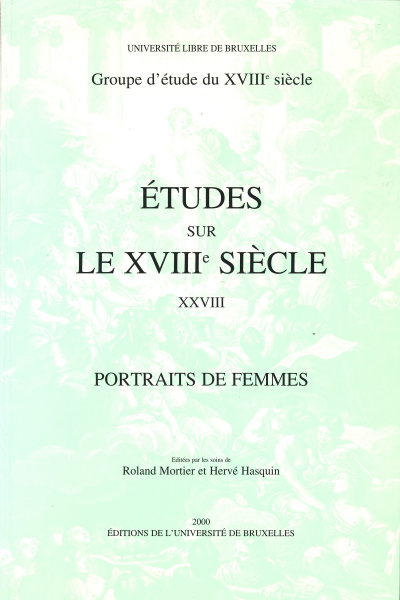Downloads
Portraits de femmes
First Edition
Edited by Roland Mortier, Hervé Hasquin
Contributions by Regina Bochenek-Franczakowa, Geneviève Goubier-Robert, Francis Ley, Gita May, Marie-Emmanuelle Plagnol-Diéval, Henri Rossi, Jürgen Siess, Samia I. Spencer, Valérie André, Yvette Went-Daoust
Ce volume consacré aux femmes de la fin du XVIIIe et du début du XIXe siècles réunit les articles de spécialistes de la littérature de cette époque.
Specifications
- Publisher
- Éditions de l'Université de Bruxelles
- Edited by
- Roland Mortier, Hervé Hasquin,
- Introduction by
- Valérie André,
- Contributions by
- Regina Bochenek-Franczakowa, Geneviève Goubier-Robert, Francis Ley, Gita May, Marie-Emmanuelle Plagnol-Diéval, Henri Rossi, Jürgen Siess, Samia I. Spencer, Valérie André, Yvette Went-Daoust,
- Journal
- Studies on the XVIIIth Century | n° 16
- ISSN
- 07721358
- Language
- French
- Supporting Website
- Digithèque de l'ULB
- Publisher Category
- Publishers own classification > History
- Publisher Category
- Publishers own classification > Language(s) & Literature(s)
- BISAC Subject Heading
- HIS037050 HISTORY / Modern / 18th Century
- Onix Audience Codes
- 06 Professional and scholarly
- CLIL (Version 2013-2019)
- 3388 Les temps Modernes (<1799)
- Subject Scheme Identifier Code
- Thema subject category: History
Paperback
- Publication Date
- 02 March 2009
- ISBN-13
- 978-2-8004-1441-6
- Extent
- Main content page count : 132
- Code
- 1441
- Dimensions
- 160 x 240 x 12 cm
- Weight
- 246 grams
- ONIX XML
- Version 2.1, Version 3
Google Book Preview
Contents
- Acknowledgements
- Foreword | Véronique HALLOIN
- Ranking and research assessment in higher education: current and future challenges | Catherine DEHON, Dirk JACOBS and Catherine VERMANDELE
- University rankings | Philippe VINCKE
- Evaluating research in Dutch universities: fifteen years of nationwide peer-review | Roel D. BENNINK
- The Dutch research assessment exercise. An evaluator's point of view | Seamus HEGARTY
- The CHE approach | Sonja BERGHOFF and Gero FEDERKEIL
- On the "multi-dimensionality" of ranking and the role of bibliometrics in university assessment | Wolfgang GLÄNZEL and Koenraad DEBACKERE
- A statistical approach to rankings: some figures and explanations for European universities | Michel LUBRANO
- Why reform Europe's universities? | Philippe AGHION, Mathias DEWATRIPONT, Caroline HOXBY, Andreu MAS-COLELL and André SAPIR
- Biographical notes

